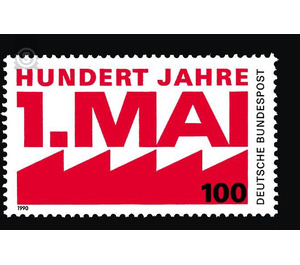100 years of labor day - Germany / Federal Republic of Germany 1990 - 100 Pfennig
Theme: Economy & Industry
| Country | Germany / Federal Republic of Germany |
| Issue Date | 1990 |
| Face Value | 100.00 |
| Color | red white |
| Perforation | K 14 |
| Printing Type | Photogravure 3-color |
| Stamp Type | Postage stamp |
| Item Type | Stamp |
| Chronological Issue Number | 1332 |
| Chronological Chapter | GER-BRD |
| Michel ID | BRD 1459 |
| SID | 465600 |
| In 57 Wishlists | |
The delegates to the founding congress of the so-called 2nd (Socialist) International in Paris, in July 1889, received an application from the French RF Lavigne: "It is time to organize a great manifestation in such a way that at the same time in all countries and countries All cities in one day should ask the workers to the public authorities (authorities) to set the working day to eight hours and carry out the other decisions of the Congress. In view of the fact that such a rally had already been approved by the American Federation of Labor on December 1, 1890, at its congress held in St. Louis, December 1888, that date is taken as the date of the international rally. In addition to the commitment to peace, it was above all the demand for an effective labor protection legislation, which was included in the May 1 resolution. These included in the opinion of the Congress u. a .: - fixing a maximum of eight hours' working day for young workers; - Prohibition of work of children under 14 years and reduction of the working day to 6 hours for both sexes; - prohibition of night work, except for certain industries whose nature requires uninterrupted operation; - prohibition of women's work in all sectors of industry whose mode of operation is particularly damaging to the woman's organism; - prohibition of night work for women and young workers under the age of 18; - uninterrupted break of at least 36 hours a week for all workers; - prohibition of those industries and operations whose health hazards are foreseeable for the workers; - prohibition of pay in foodstuffs and of the entrepreneurial shop (canteens, etc.); - Prohibition of intermediate contractors (sweat system). The Congress declared that all these measures necessary for the recovery of social conditions should be the subject of international treaties and laws, and called upon the proletarians of all countries to influence their governments in this sense. He demanded in principle: equal wages for equal work for both sexes and without distinction of nationality. On May 1, 1890, May Day celebrations marked the first May Day celebrations in some countries. The type of celebration was very different. It depended on the prevailing political and economic conditions in each country. In Germany there was still the Socialist Law, which prohibited the organization of social democracy and severely restricted most trade unions. Nevertheless, numerous events were held on May 1 or the following Sunday in Germany under strong police surveillance. Work stoppages were answered by the entrepreneurs with lockouts. In Germany, this has led to numerous discussions in the workers' movement about the most effective implementation. The central demand of the resolution of 1889 - the eight-hour day - was indeed achieved in Germany in the November Revolution of 1918, but in the following years he often had to be defended - not always successfully. The May Day celebrations in the years of the Weimar Republic were essentially shaped by the division of the German workers' movement. In other words, there were separate Social Democratic and Communist May holidays, with clashes between demonstrators in some places. When, on May 1, 1929, communists demonstrated despite a ban issued by the Social Democratic chief of police, more than 20 demonstrators were killed in clashes with the police. The division of the German labor movement was further aggravated by this. Shortly after her seizure of power in 1933, the National Socialists succeeded in temporarily unsettling the leadership of the Social Democratic General Trade Union Confederation (ADGB) with the imposition of May 1 on the »Holiday of National Labor«. However, as early as May 2, 1933, the occupation of the trade union houses by SA and SS suppressed the democratic trade union movement. The idea of May 1 of the labor movement had not been lost during the Nazi era. As early as May 1, 1946, in many places in West Germany - despite the difficult economic situation - May holidays were again organized by the new unions. Although the original demands of 1889 have been met, May 1 remains the central demonstration day for workers. (Text: Dr. Dieter Schuster, DGB Federal Board)
| Condition | Name | In Stock | Price | Price + Shipping | Store | |
|---|---|---|---|---|---|---|
 | Used | 100 years of labor day - Germany / Federal Republic of Germany 1990 - 100 Pfennig | 1 | US $0.257 | N/A |  Utestamps (0) Utestamps (0)Request a Shipping Quote Minimum Lot Average US $1.92 |


